Ballerina
Beauty and the Beast- Comparing the Disney Movie & the Ballet
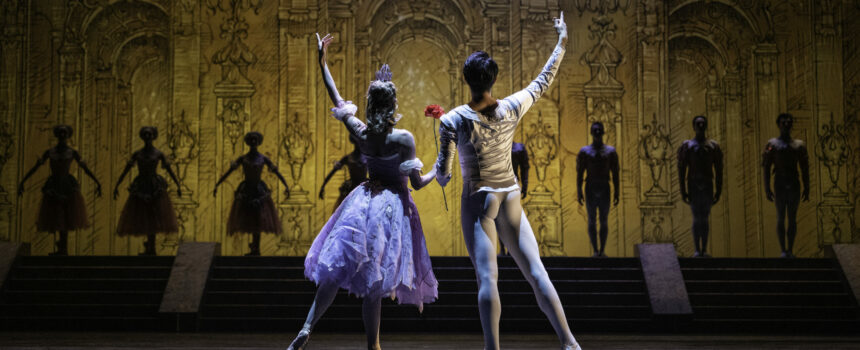

Pittsburgh Ballet Theatre will present Beauty and the Beast at the Benedum Center from February 16-25. This whimsical, imaginative work with charming characters and challenging choreography has turned a classic fairytale into an enchanting storybook ballet. Audiences of all ages will delight in this ballet as it illustrates that “there is often more than what meets the eye.
It’s a tale as old as time, but how close is PBT’s Beauty and the Beast ballet to the story of which most people are accustomed?
PBT performs a ballet adaptation of Beauty and the Beast choreographed in 1958 by Lew Christensen, an influential dancer and choreographer who worked with the famed George Balanchine and served as artistic director of the San Francisco Ballet for 32 years.
While maintaining similar characteristics to the widely-known Walt Disney Pictures Beauty and the Beast, Christensen’s version was choreographed before the movie was produced and shares more of a likeness to earlier published versions of the beloved story.
A History of Beauty and the Beast
1740: There are fairytales from cultures all over the world that share elements of the Beauty and the Beast story. However, the first known publication of this specific tale (La Belle et la Bête) was written in 1740 by French novelist Gabrielle-Suzanne Barbot de Villeneuve.
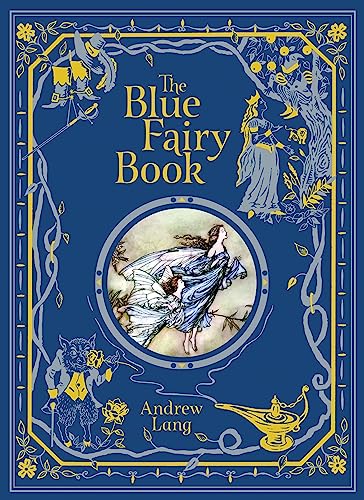
1756: Villeneuve’s lengthy version was abridged, rewritten, and published by French novelist Jeanne-Marie Leprince de Beaumont.
1889: Scottish poet and novelist Andrew Lang published the Fairy Book series, a collection of 12 volumes of traditional fairy tales. In the first of these volumes, The Blue Fairy Book, he published “Beauty and the Beast,” alongside classic tales like “Hansel and Gretel,” “Aladdin and the Wonderful Lamp,” “Little Red Riding Hood,” “The Forty Thieves,” and “Snow-White and Rose-Red.”
1958: Lew Christensen choreographed a brand new ballet in celebration of San Francisco Ballet’s 25th anniversary, set to orchestrations by famed composer Tchaikovsky. Praised as “the most delightful, imaginative, enchanting and accomplished ballet production to grace the Opera House stage,” by the San Francisco News, this ballet has been revived numerous times over the past 65 years by ballet companies like PBT.
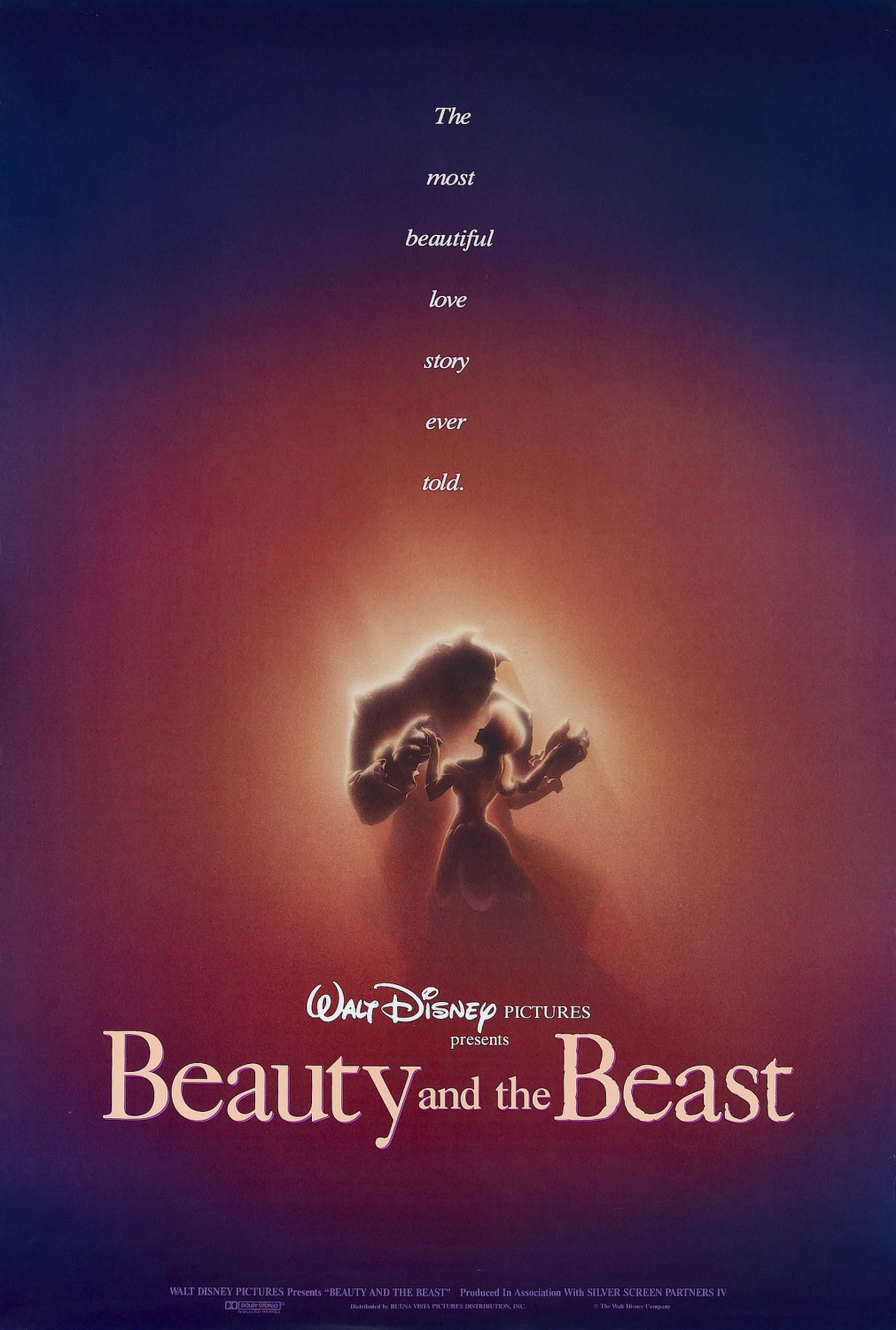
1991: Walt Disney Pictures released the animated film that has become famous around the world. The movie was wildly successful, winning the 1991 Golden Globe Award for “Best Motion Picture – Musical or Comedy” and the Academy Awards for both “Best Original Score” and “Best Original Song” for its titular song.
1994: Beauty and the Beast became Disney’s first animated film to be adapted into a Broadway musical.
2017: Walt Disney Pictures produced a live-action remake starring Emma Watson.
Since Villeneuve’s 1740 publication, there have been hundreds of books, movies, stage productions and TV shows adapting the story.
Comparing the Versions
| Story Elements | The 1991 Disney Movie | The PBT Ballet |
| Beauty’s Capture | After wandering into the Beast’s castle and making himself at home, Belle’s father is imprisoned. Belle offers to stay as the Beast’s captive in exchange for her father’s freedom. | Beauty’s father picks a rose from the Beast’s garden for his daughter. In anger, the Beast holds Beauty captive and banishes her father. |
| Characters in the Castle | A curse on the castle has transformed the staff into enchanted household objects like clocks, teapots and candlesticks. These characters become Belle’s friends. | Beauty is comforted and entertained by enchanted flowers, caryatids (statues), simians (monkeys), and bluebirds in the enchanted castle and gardens. |
| Villians | Belle is pursued by the boorish Gaston, who later challenges the Beast for Belle’s affection. | Beauty has multiple jealous sisters at home who envy the beautiful gifts the Beast has given her. |
| The Beast’s Death | In a fight to the death with Gaston, the Beast is fatally stabbed. Upon his death, Belle admits her love for him and his curse breaks, bringing him back to life as a handsome prince. | Terrified of the Beast and longing for her family, Beauty flees the castle. Grief-stricken, the Beast dies of a broken heart. After returning home, Beauty realizes her affection for the Beast, and returns to the castle to find him lifeless. Heartbroken, Beauty sobs, now knowing that she loves him. The Beast stirs and tears away his clothes and fur to reveal a handsome prince. |
We know you’ll be enchanted by PBT’s Beauty and the Beast! Showcasing the transformative power of love, the ballet is completed with stunning choreography, gorgeous costumes, and spectacular sets. Join us at the Benedum Center from February 16-25!
New Dancer Spotlight: Christian García Campos
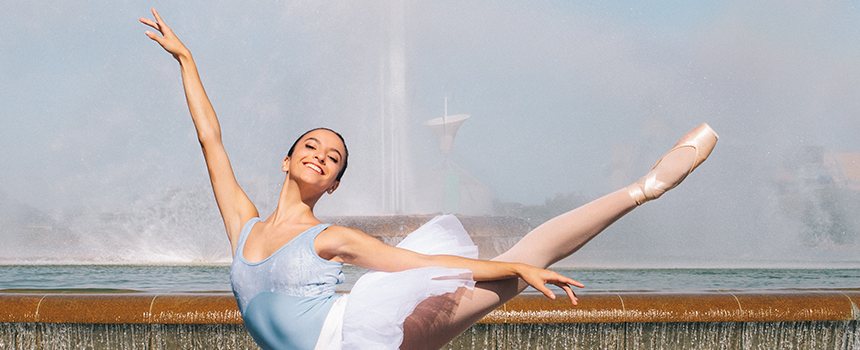
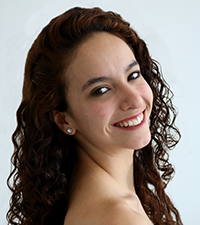 Artistic Terrence S. Orr recruited Christian García Campos, of Puebla, Mexico, to the company from the PBT School Graduate Program, where she has trained since 2014 — first as a full-time high school student and then as a Graduate student. She’ll make her official company debut at PBT’s Aug. 19, Ballet Under the Stars performance at Hartwood Acres, followed by the company’s main-stage season opener Mozart in Motion in October. Get to know Christian here.
Artistic Terrence S. Orr recruited Christian García Campos, of Puebla, Mexico, to the company from the PBT School Graduate Program, where she has trained since 2014 — first as a full-time high school student and then as a Graduate student. She’ll make her official company debut at PBT’s Aug. 19, Ballet Under the Stars performance at Hartwood Acres, followed by the company’s main-stage season opener Mozart in Motion in October. Get to know Christian here.
Fun Facts
Tell us about your…
Hometown: Puebla, Pue., México
Family: “With two surgeons as parents, both my sister and I decided dance was our path. She has a dance studio back home.”
Pre-performance ritual: “I try to relax myself with music, but I definitely cross myself before entering the stage.”
Hobbies: Playing the piano, drawing and writing
Favorite food: Tacos and sushi
Favorite song: “No no no” by Beirut
Ultimate dream role: Juliet (Romeo and Juliet) or Nikiya (La Bayadère)
Favorite role to date: A bride in PBT’s production of Dracula
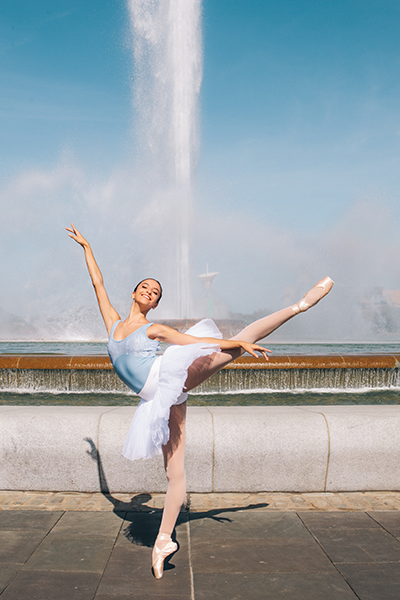 Q&A
Q&A
How do you think you’ve grown as an artist during your time in the PBT School Graduate Program?
“I believe that I have matured my dancing, trying to pay more attention to the small but meaningful details, which make the difference. I also think I’ve worked on trying to throw myself out there without worrying about the outcome. That usually does the trick, which hopefully will help throughout next year.”
Describe your ballet “epiphany” – the moment you knew this was what you wanted to do professionally.
“I don’t think there was an exact moment, but I remember that when I was younger in my home studio, I would love going to rehearsals. My fun on Fridays and Saturdays wouldn’t be about parties, it would be about going to do what I loved the most. Some people wouldn’t understand it, but that’s how I knew I wanted to keep doing this for however long I could.”
What are some of your personal goals for your first season as a company dancer?
“I want to grow as a teammate. I believe the experience that you get as a student might be different from the one you get as a professional dancer with your coworkers. I also want to expand myself and be brave in doing things I’m not used to doing, to not stay in a comfort zone, not to focus too much on certain things so I don’t forget to loosen up a bit.”
What’s the most fulfilling thing about being a ballet dancer?
“There’s just so much to it. It’s like entering a whole new world that not everybody gets to experience. To be backstage, to witness how magic gets done before a show, and of course being on stage. It’s like escaping reality for a little bit. The lights, the costumes and makeup, how the music completely wraps up my entire focus. I live for those tiny moments that happen in which I indulge completely in the moment, and I couldn’t be more satisfied than that.”
What are you most looking forward to dancing next season?
“Definitely Mozart in Motion; it’s not every day that you get to dance something a little less classical and what better than (these works by George Balanchine and Jiří Kylián). Also I’m very curious about The Great Gatsby. ”
If I weren’t a ballet dancer, I would be…
“A marine biologist. The ocean mesmerizes me and I love animals way too much (haha). It’s always been sort of a dream to work with dolphins.”
Q&A: 4 Ballerinas On What It’s Like to Be Swan Queen
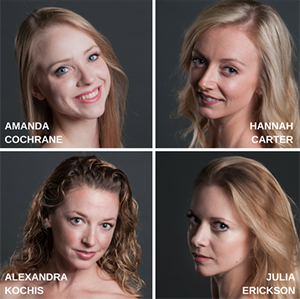 In the classical ballet Swan Lake, the ballerina’s dual role of Odette/Odile, commonly referred to as White Swan/Black Swan, is one of the most iconic in the repertoire, demanding technical mastery and emotional range to morph from vulnerable and pure Odette to audacious and deceptive Odile. Thematically, these polar-opposite personalities symbolize a battle between good and evil. Choreographically, they also contrast. Odette is fluid and ethereal with the delicate carriage and rippling swan arms that are a signature of the ballet. Odile is virtuosic, demanding attention with a series of heart-pumping jumps and turns, including the famous 32 fouettes of Act 3.
In the classical ballet Swan Lake, the ballerina’s dual role of Odette/Odile, commonly referred to as White Swan/Black Swan, is one of the most iconic in the repertoire, demanding technical mastery and emotional range to morph from vulnerable and pure Odette to audacious and deceptive Odile. Thematically, these polar-opposite personalities symbolize a battle between good and evil. Choreographically, they also contrast. Odette is fluid and ethereal with the delicate carriage and rippling swan arms that are a signature of the ballet. Odile is virtuosic, demanding attention with a series of heart-pumping jumps and turns, including the famous 32 fouettes of Act 3.
Here, PBT’s four principal ballerinas and Swan Queens — Amanda Cochrane, Hannah Carter, Julia Erickson and Alexandra Kochis — share insights on portraying two complex characters in one production.
Describe what makes Odette’s technique unique. How do you make it your own?
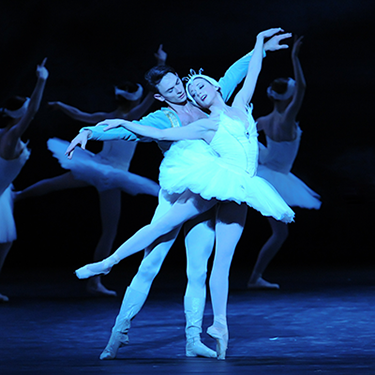
AC: I find one of the most wonderful things about being Odette and Odile is that you have so much room to play with port de bras and the musicality. I like to experiment with different arm movements, and I try to make each rehearsal slightly different, whether I’m exploring the music or just holding a balance a second longer. This allows me to discover what feels natural and expand on things that work for me as an artist/dancer.
HC: Odette’s technique, along with the corps de ballet of swans, uniqueness comes mainly from her port de bras, the way she uses her arms. They are our wings and we try our best to make them look that way.
JE: It diverges from classical, rounded ballet port de bras shapes, because you’re portraying a swan with the swan arms. You need all the carriage of classical ballet technique but then you kind of flip the hand. The beauty of Odette’s technique is that it’s very fluid. You’re able to play a lot more than with your average classical ballet role, so that is very fun. It’s all about length and expression and covering space.
AK: Dancing the role of Odette is classical vocabulary, extrapolated. You are extending a pointed toe but only to better probe the waters. You are raising your arms and inclining your head but with the purpose of unfurling your wings and preening your feathers. The role gives meaning to the movements.
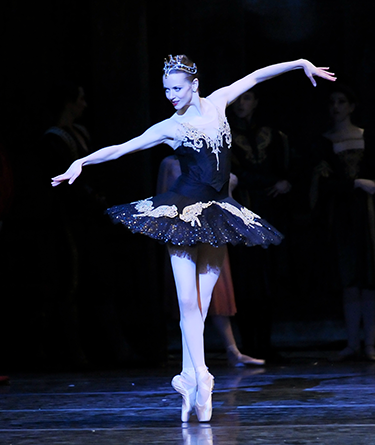
How do you switch gears from vulnerable Odette to audacious Odile? Describe your interpretation of each character.
AC: Odette and Odile are such polar opposites, I feel like I have to flip an internal switch when I bounce back and forth between the two roles. I approach Odette with a feeling of longing and desire. I try to give her backstory a wounded innocence with a hint of a wild creature, all behind the queenly authority that she has to protect her flock. I see Odette as a strong, enduring soul whose kindness and love triumph evil. Odile is a bit of a trickster. She has to be cunning and seductive without giving away her true identity. I try to give this role more spark and a commanding/alluring presence to deceive the prince. Odile is enthralled by the challenge of winning over Siegfried.
HC: The music and change of costume is going to be a big help for me in switching from Odette to Odile. Odette wears this beautiful white tutu and then Odile is a black tutu with gold lace trim on it that is just as beautiful in its own way. It makes you feel powerful and in charge with a sense of allure. The music does exactly the same thing.
JE: I definitely like to think about it as they’re these two archetypes…these are extremes and they’re portrayed as such. Odile is just the black mirror version of Odette — if you were to take Odette in all her innocence and beauty and purity and flip it on its head. With Odette, I think we’ve all felt those vulnerabilities of being seemingly lost, our hearts breaking, we feel there’s no hope and then this incredible thing happens and you feel so alive. That’s such a magical thing. Everyone’s felt that – probably too few times in our lives. It’s beautiful in its tragedy and also in its hope. And then Odile is so much fun because basically you’re a trickster. You get to really run the show and plot. Everything is working in your favor. Odile is so confident that she’s just in the flow. The cards are falling exactly how they’re supposed to.
AK: Tchaikovsky’s music drives my transformation. I only need hear the first few coursing notes of Odile’s entrance into the ballroom scene in the third act to feel like the powerful and scintillating seductress that she is in my mind. These characters live in each of us – the two sides of a coin, the yin and the yang. The fun part of dancing this role is getting in touch with each of them as they exist in you and then giving them a voice.
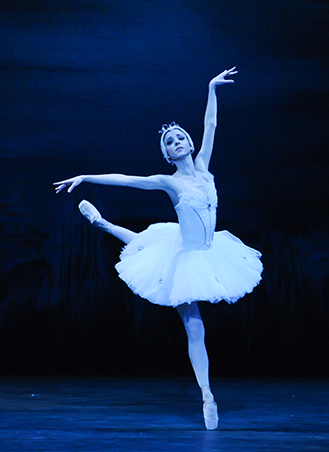
What makes this a bucket list (dual) role?
AC: I have a special place in my heart for Swan Lake. I have loved this ballet since I was young. This iconic score gives me chills down my spine every time I hear it. The technical challenges that come with these roles is something to be conquered and to be proud of when you’ve accomplished what you set out to do. This is a true prima ballerina role that is an honor to perform.
HC: I love dancing classical ballets, and Swan Lake is one of the most famous. I grew up watching the big names dancing roles like Odette/Odile and knew that’s what i wanted to do. I hope i can do it justice.
JE: I think it’s the incredible challenge of having to dance two characters and have two different levels of energy. To transition from Odette to Odile and back to Odette, to have the opportunity to conquer that challenge in an evening of ballet and take the audience on that ride with you, I think it’s a bucket list role because of that. It’s so fun because you have this beautiful freedom of expression. Everyone who’s danced it has danced it so differently…Your individuality really comes out, which is wonderful.
AK: Within the classical lexicon, the role of Odette/Odile is regarded as a pinnacle of both dramatic and technical prowess. To dance it is to go beyond yourself to a realm of suspended disbelief – where sorcerers do exist and it is possible for a prince to fall in love with a swan queen.
What makes Swan Lake special to you?
AC: Just having the opportunity to be onstage performing this beloved role makes this a special show for me.
HC: I’ve danced the corps de ballet of swan lake many times and have been fortunate enough to dance in different productions with different companies. It’s going to be a new experience and a new challenge dancing this role.
JE: I saw Pacific Northwest Ballet do Swan Lake back when I was a little kid. I was in the front row. I remember being just floored by how beautiful it was. Later in high school…I got the CD and I used to listen to it in my car b/c (the music is) just so compellingly beautiful. This will be my sixth full-length Swan Lake, and it was really my first full-length ballet. I remember being on the journey of my first Swan Lake performance and how it opened me up and took my dancing to another level. I feel like everytime I dance it it does the same thing.
AK: Throughout my career Swan Lake has been a frequent visitor. I have danced many roles, from the corps de ballet on up to Odette/Odile, and had the honor of watching so many beautiful artists make it their own. It is an incredibly special process to take all of this knowledge that you possess at this particular time in your life and assemble it into a unique version of the Swan Queen.
#PBTNutcracker: How 1 Ballerina Balances 14 Roles
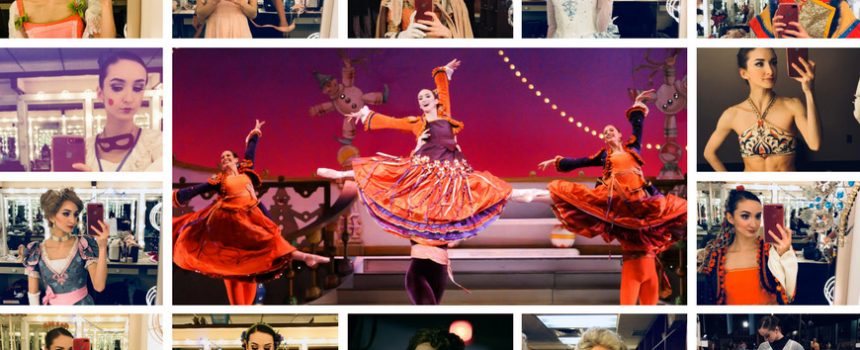
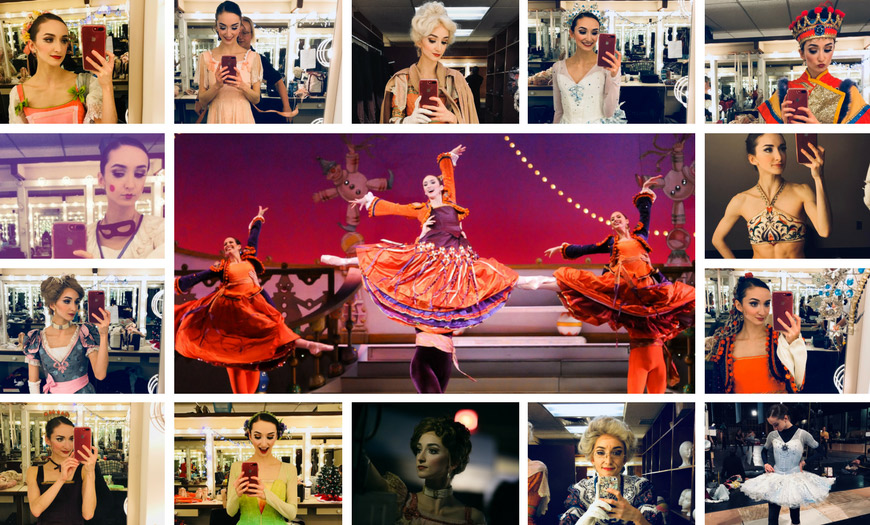
With 24 performances throughout December and unique casting combinations for each, the cast list for The Nutcracker is something of a Rubik’s Cube. How does one ballerina juggle 14 roles across 24 performances of The Nutcracker? Corps de ballet dancer Jessica McCann lets us in on her secrets to success.
First, name all 14 roles for us.
Arabian, Chinese, Columbina doll, Mrs. Kaufmann, Flowers, Aunt Gertrude, Grandmother, Marie, Snow Queen, Snow corps de ballet, Shepherdess, Spanish lead, Spanish side, Mrs. Stahlbaum.
What’s it like to learn and dance 14 roles? How do you keep it straight?!
“It’s kind of crazy isn’t it?! Each year, we slowly learn and perform more roles and are given more opportunities. So the number of roles just continues to increase as your years in the company progress. It’s exciting adding new roles and perfecting older ones. Before every show I really focus down on what I’m doing in this show and try not to worry about anything else. Getting into character really helps me with that because it’s the same music, but depending on your role that night…your timing is different or you’re in charge of something different. It’s always important to try things in a costume before your show, especially when we all do so many different roles. It’s a lot!”
Do you have a favorite role or even a top three? What makes each one special?
“I might have to say, Marie, Snow Queen, and Arabian…Aunties from the party scene come very close though! (They are so funny…If you ever seen me perform it, you’ll probably notice how much fun I’m having!) Marie is, of course, my top pick. I really enjoy playing a character that drives the story. She is so full of life and wonder; you get to play with a lot of different acting while being Marie, including young love. Snow Queen and Arabian are my second and third picks. Being queen of the land of snow is probably my inner child’s dream coming true! The music is powerful and exciting. She is powerful but kind and understanding, and her entrance is one of my favorite things. A huge book opens up and the Snow King and Queen emerge through it. Arabian is the newest role for me…It’s challenging and rewarding, and I love the mysterious quality to the movement.”
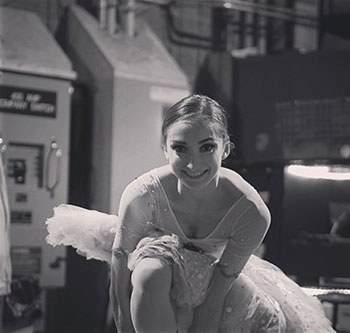 How do you keep your energy up throughout the run?
How do you keep your energy up throughout the run?
“The whole company is constantly picking each other up – helping and encouraging each other, watching each other in the wings, constantly joking around and reminding each other to just have fun! It’s a long month, but we get through together.
I take a lot of vitamins…amino acids and omega-3 & 6. Lots of water…protein….smoothies, antioxidants and eggs and homemade protein bars with lots of different nuts and seeds as well as yogurt and homemade granola. I also tend to try and lay down and shut my eyes in between performances if time allows. I need to rest my mind and prepare and recharge for the next show filled with different roles then the shows previous. How we treat our bodies and minds when we are so busy pretty much makes or breaks you. You need to stay strong and healthy to make it through! We always have a dinner waiting for us in the crockpot on those nights when we come home at 11 p.m. as well. No matter how tired you are you need a good dinner too.”
What’s your favorite costume of the 14 you wear?
“This is hard… last season I had my Snow Queen premiere and I might have to say that one is my favorite. The Snow Scene has been my favorite scene in The Nutcracker since I started dance at 4 years old. The tutu and tiara are just gorgeous and I feel like a true ballerina when I’m in it.”
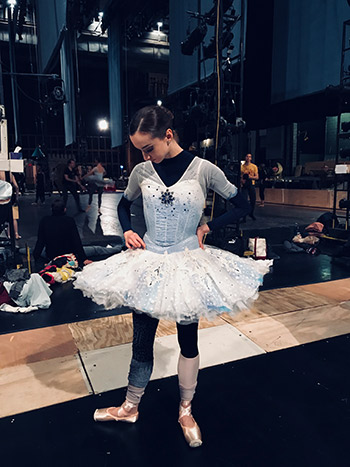 Do you prep a different pair of pointe shoes for each role?
Do you prep a different pair of pointe shoes for each role?
“Definitely yes! (Dancing in the) Snow Scene corps de ballet always gets my deadest of dead shoes. It’s a lot of jumping and running, so soft is okay. I wear a brand-new pair when I do Marie, and it’s perfect. You need them harder in the beginning and it’s nice as they soften during the show, because in Act 2 there is much more jumping. If those shoes are still good I might wear them later for a Chinese show or Spanish lead show. Chinese, Shepherdess and Snow Queen need really nice turning shoes so they can’t be too dead, but not brand new. Comfortable. I might even transition my Marie shoes to my Snow Queen shoes. It totally depends on the role, the choreography, and what each individual dancer likes. I’m definitely walking around with a ton of different pointe shoes though, always trying to find the perfect pair for the roles I’m doing that day.”
What does The Nutcracker season mean to you?
“It’s all about family and tradition isn’t it? It’s something that touches young kids and they never forget it. My mother never forgot when she first saw it, and I’ll never forget when I first saw it. It’s a famous story everyone knows one way or another, and it’s a beautiful tradition that families make. I love being a part of so many families’ traditions each year.”
See all of these characters come to life in Pittsburgh Ballet Theatre’s The Nutcracker, on stage through Dec. 27, at the Benedum Center. Get your seats here.
Artist Spotlight: Meet Our Newest Soloist
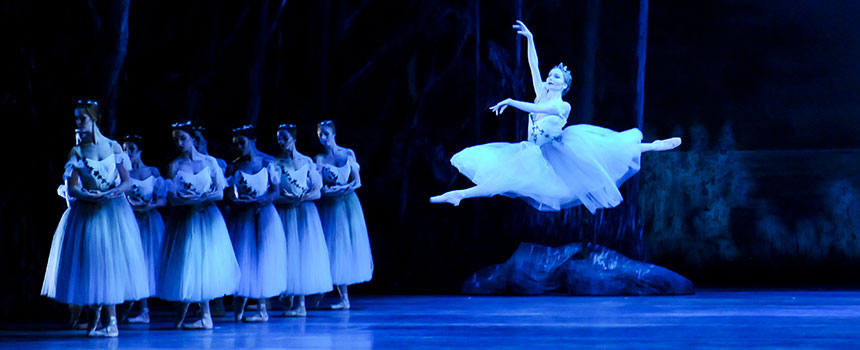
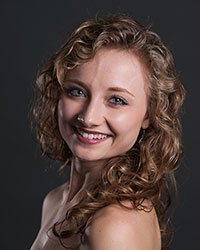
When Diana Yohe next steps on stage, it will be as a Pittsburgh Ballet Theatre soloist. Yohe, an alumna of the PBT School Graduate program, joined the company in 2013 as a member of the Corps de Ballet. Over her four seasons with PBT, she has danced an increasing number of featured roles, including Myrtha in PBT’s October production of Giselle and Alice in its February production of Alice in Wonderland. She’s also racked up an impressive number of contemporary credits ranging from Jiří Kylián’s Petite Mort and Sinfonietta to William Forsythe’s In the Middle, Somewhat Elevated, Twyla Tharp’s In the Upper Room and James Kudelka’s The Man in Black. Diana trained under Courtney Laves and Mark Otloski at the City Ballet of Cleveland before pursuing pre-professional training in Joffrey Ballet’s Trainee Program and in PBT School’s Graduate Program, which she joined in 2012. Get to know Diana here.
Fun Facts
Family: I have the most incredible support system. They come to every show, sometimes multiple times. They are the most wonderful people.
Pre-performance Ritual: I don’t have a specific routine, but I always say a quick prayer before getting on stage!
Most-played Music Right Now: The most recent CD I bought was Frank Sinatra. I love the old classics.
Hobbies: I am most definitely a book worm. I also love cooking and baking, along with traveling with my fiancé, Joe. He jokes that wedding planning is my new hobby!
Dream Role: My dream classical role would be Giselle. Otherwise I’d have to say that performing the pas de deux from After the Rain will always be a dream of mine!
Favorite Role to Date: Myrtha from Giselle. I thoroughly enjoyed exploring her character and she was a difficult role to perform since I am generally smiling.
Go-to Relaxation Activity: Reading would be my number 1. Retail therapy is always a way to help a girl relax too!
Misc. Fun Fact: I’m a leftie.
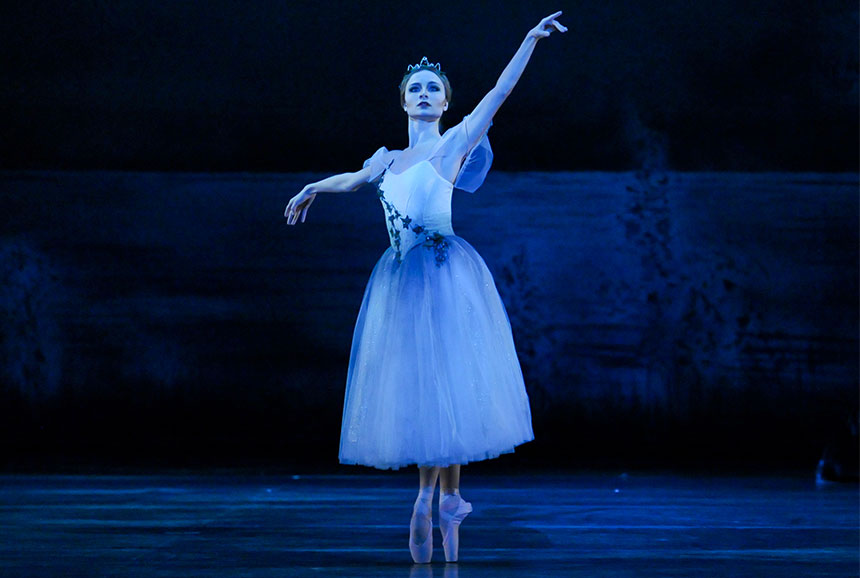
Q&A
How does it feel to be a soloist? How did you react and/or celebrate when you got the news?
“I don’t know yet! I know I’ll keep dancing just as hard and enjoying every day I get to do what I love. The day I found out I was promoted, I had arrived at work a little early. Once I knew, the first two people I ran in to were my best friend and my fiancé. I’ll never forget the big hugs I got from both of them!! I later celebrated with friends, getting my favorite pizza in Pittsburgh, at Pizza Taglio.”
How do you think you’ve grown as an artist since you first joined the company?
“I feel that a lot of growing as an artist comes with growing as a person. Every part I’ve performed I feel has taught me something new and helped me learn a little bit more about myself.”
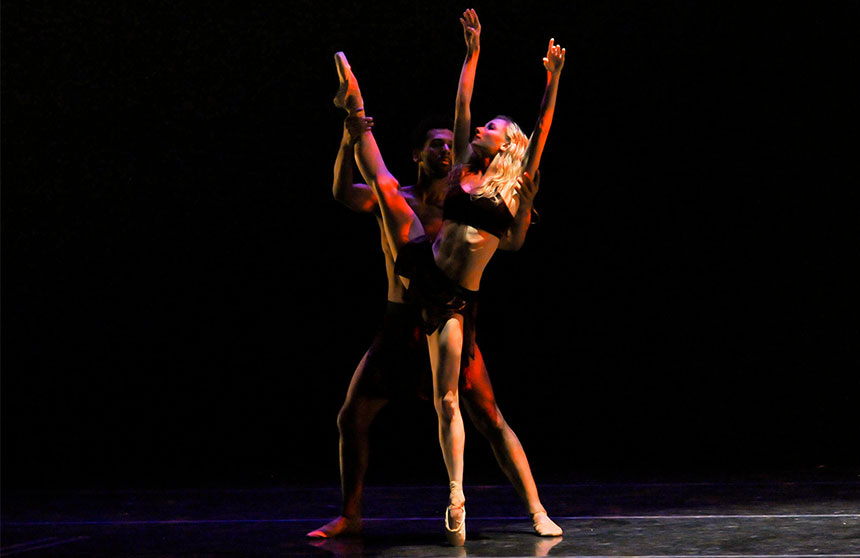
Could you describe the rush of performing, your connection with the audience and what it’s like being in the moment, performing, after so much preparation?
“Nothing compares to being on stage. My main goal once I get to the stage is to enjoy the moment and to share the joy I feel with the audience. When I’m out there I just try to relax in what I’m dancing and trust the preparation that got me there.”
Describe your most memorable role with PBT to date.
“In the Upper Room by Twyla Tharp was the first ballet I performed as a dancer with Pittsburgh Ballet Theatre. I can still remember how I felt during that show. It was incredibly special to me as it was my first time performing as a professional and it is a very difficult ballet to dance. Every time I hear the music by Phillip Glass it takes me back to that time in my life.”
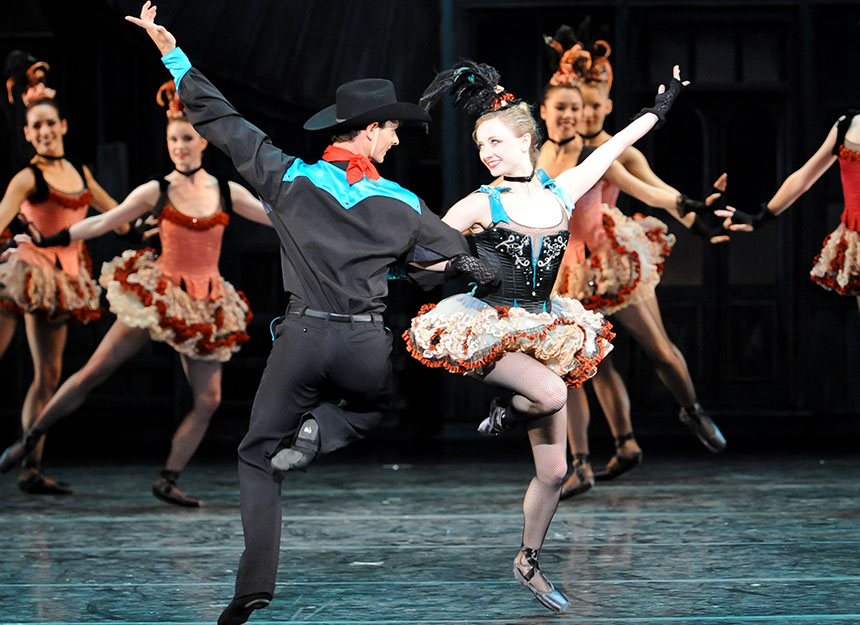
What qualities do you strive to bring to your dancing?
“Understanding a character has become more and more important to me. Dancing becomes even more enjoyable when you have a story behind the movement.”
Why ballet? What does it mean it you?
“I love that ballet is a balance of artistry and athleticism. It is truly a challenge that never dwindles! From the very first time I performed in The Nutcracker, I knew it was my dream to be a professional ballet dancer. I had no idea what I was getting myself into! I wouldn’t change a single choice I made though. I have loved every moment of the ride ballet has taken me on.”
What are you most excited about for next season?
“We have awesome programs scheduled for next season, but if I had to choose I’d say I’m looking forward to Dracula. I have never performed it, but the dancers that have are all very excited to perform it again!”
A Dancer’s Tips for Dynamic Dance Photos
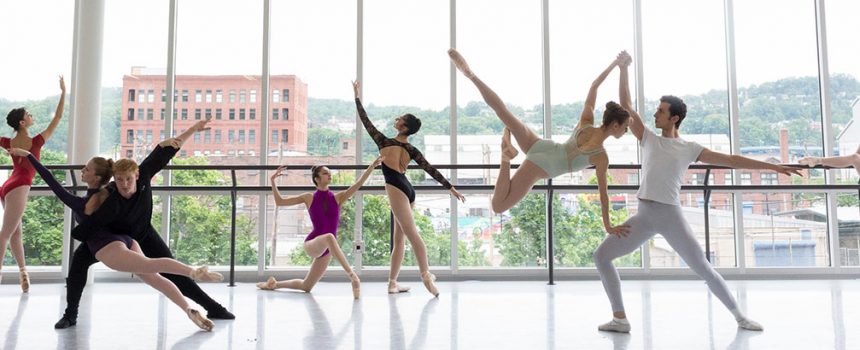
On a recent weekday afternoon, a group of ballet dancers ducked into the shell of an abandoned Strip District building for an impromptu photo shoot. Like the greenery sprouting between the slabs of concrete, the dancers made this unlikely spot their studio for a few hours, striking pose after pose against the graffitied cement walls.
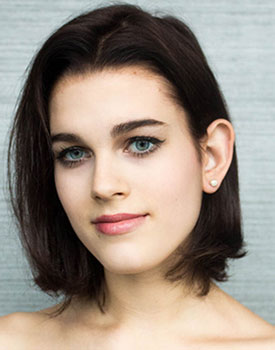
Behind the lens was someone with an eye for a good location: 20-year-old Emily Northrop, who’d noticed the wide-open space, the light streaming through the steel frame and the chance to juxtapose the gritty space with graceful dancers.
But she also brought something even more important to the table: an innate sense of timing. Northrop, along with her subjects, is a pre-professional dancer in PBT School’s Graduate Program.
It’s no small task to translate the dynamism of dance to a still photograph. In dance photography, much depends on the timing. It’s the key to catching a fully extended arabesque or a grand jeté at the pinnacle of its arc.
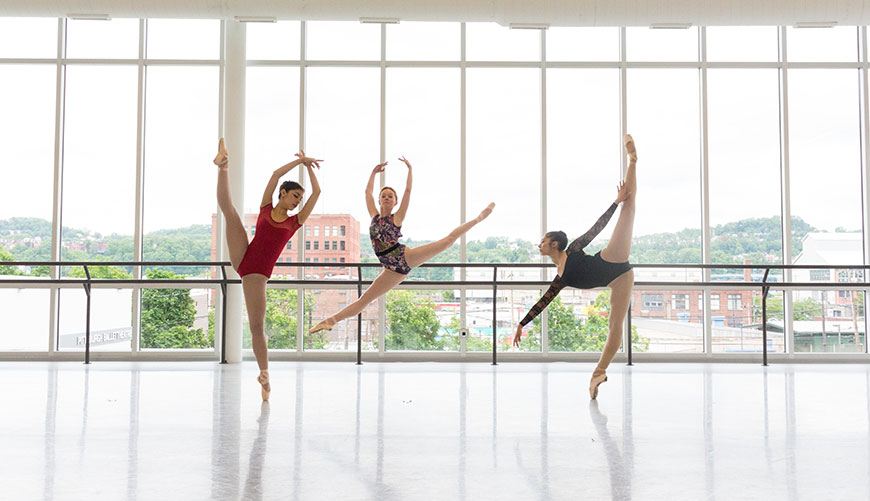
So it’s no surprise that many successful dance photographers, like Northrop’s role model Rachel Neville, are former dancers. It’s essential for capturing both the energy and the technique at their peak.
A Florida native, Northrop grew up in Seattle and started dancing around age 10. She trained at Pacific Northwest Ballet through high school, where she took her first photography class, and just finished her second year in PBT School’s Graduate Program.
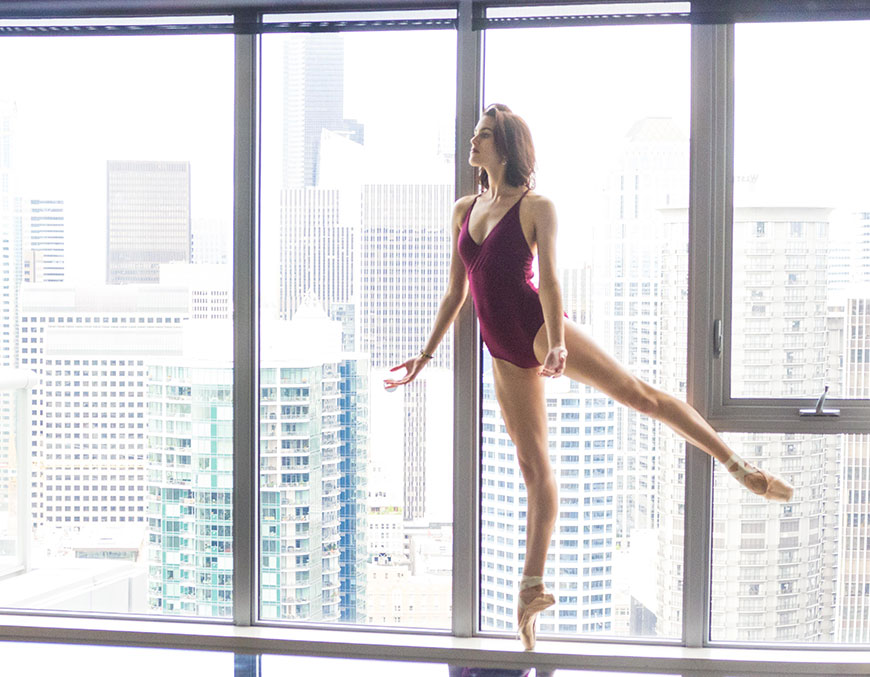
“I think I really enjoy how you see your hard work pay off,” Northrop said of her love for ballet. “It’s a great way to express yourself and work through feelings. When I have stressful stuff going on in my life, when I dance it just completely erases all of the stress.”
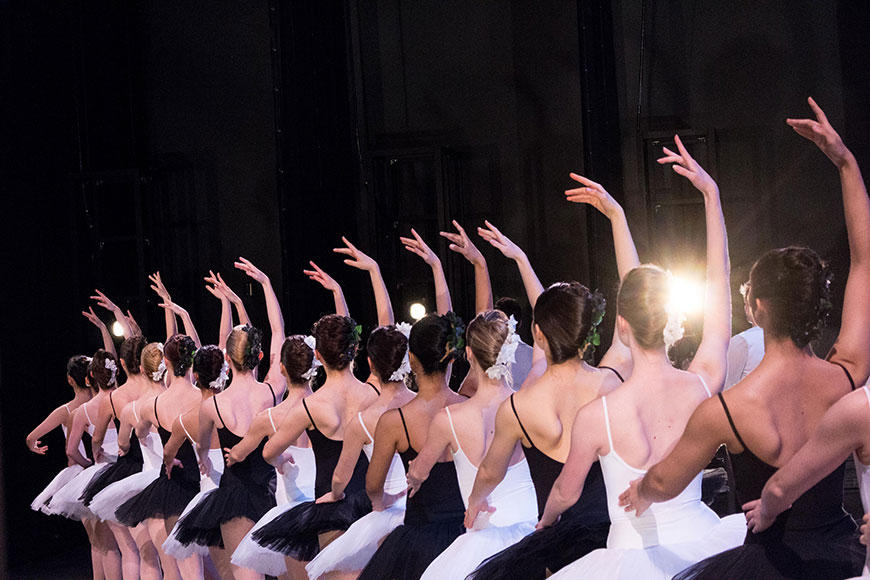
Over the past year, Northrop began merging her two artistic passions. She saved up to buy a camera and started heading to photography classes at Pittsburgh Filmmakers after ballet each day.
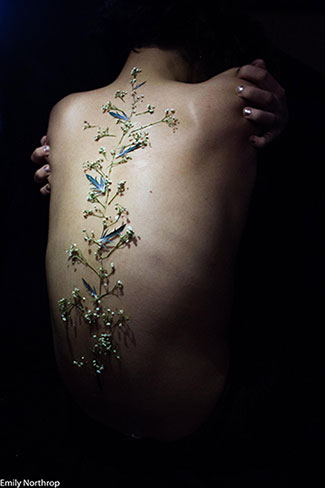
She started her practice with portraits.
“I like to do portraits that have meaning behind them. They’re not just faces, they have an important message to say.”
Around the New Year, she began experimenting with dance – and that elusive ability to effectively freeze motion into one frame.
“Being a dancer helps immensely,” Northrop said. “When I’m taking the photos I can feel the timing in my body. Knowing the technique…you know how to turn the angles to make the dancers body look the best.”
Over time, and after taking a weekend workshop with Neville, whose photographs have been featured in Dance and Pointe magazines and by a variety of dance companies, Northrop began cultivating more detailed concepts for each shoot.
“I’ve been thinking more in the form of shapes rather than dance poses,” Northrop said. “For some of my dance photos, the ones that are a little bit more thought out…I thought of a word I wanted to express first and we did a bunch of different poses that expressed that word.”
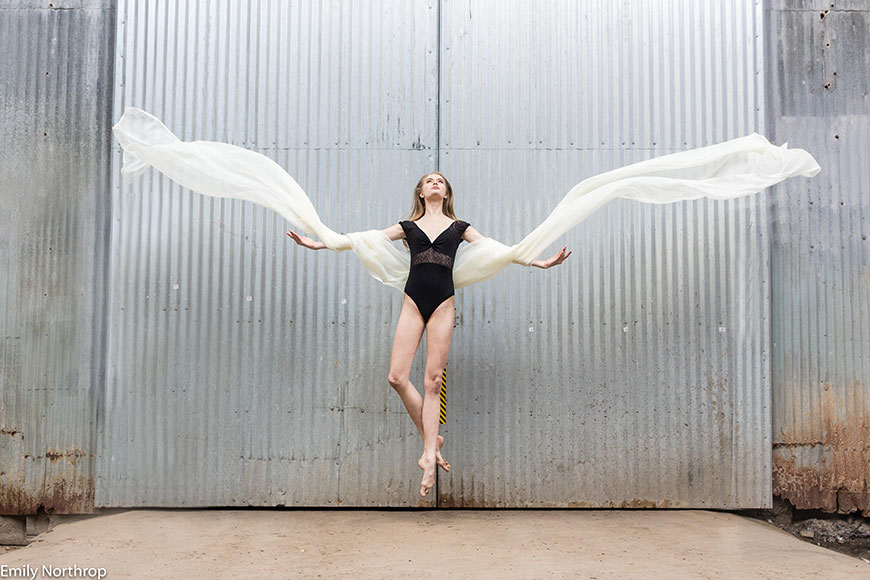
For inspiration, Northrop scrolls through thousands of Pinterest photos, admiring other photographers’ work and filling her mind with ideas.
“I’ll look at thousands of images. When I go to bed it will be in my brain and when I wake up usually there will be some ideas there.”
She’s also taken inspiration from Neville’s ability to coax peak performance from her subjects and to conceptualize photos that put interesting dynamics at play.
“I noticed that (Neville) definitely pushes the dancers to their limits technique wise to get the best technical photo,” she said. “Now I am definitely more picky. I will give many, many corrections for one pose…to get the very best that they can make it look.”
Whether it’s dance, portraits or artistic side projects, Northrop showcases her work on Instagram under the handle @NorthropPhotography and on Facebook. One day she hopes to make it professional. For now, much like her 10-year pursuit of ballet, it’s all about the practice.
“I feel like the only way you get better is by practicing more and more. I really do love it.”
For more inspiring dance stories, plus exclusive ticket promos, sign up for the PBT e-news here.
#FacesOfBalletPgh: Dr. Melonie Nance
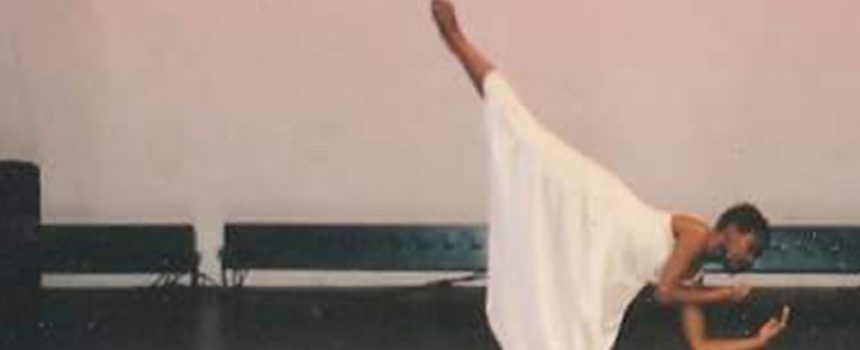
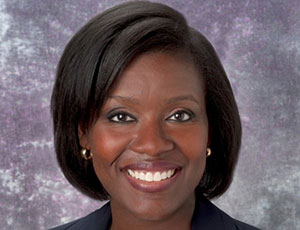
#FacesOfBalletPgh: Dr. Melonie Nance
ENT otolaryngologist, Pittsburgh Ballet Theatre Trustee, PBT + Dance Theatre of Harlem committee co-chair
Dr. Melonie Nance is a surgeon, a wife and a mother. But for much of her life, she was a dancer. It shaped her identity then, and it remains part of it today.
Dr. Nance threw body and soul into ballet beginning at age 8. In high school she made the difficult decision to prioritize academics, and a future career in medicine, over a rigorous pre-professional training schedule. In college, she rekindled her passion for dancing and performing, but faced an inner conflict with the dance form she’d grown up loving.
Now, years later, her 3.5-year-old daughter, Lalitha, is the one dancing. And, as a member of the Pittsburgh Ballet Theatre Board of Trustees and co-chair of the committee supporting PBT’s collaboration with Dance Theatre of Harlem, Dr. Nance is back to playing an integral role in the art form she’s loved for so long.
Here, she shares what drew her to ballet, what pushed her away, and ultimately what brought her back.
How did you first get into ballet?
“My mom took me to ballet when I was little. But she tells me that even when I was 3 years old I was the one that asked her if I could go to dance class. I took ballet when I was a little girl – ballet, tap and jazz – and then stopped when school got started and a I took piano and other things. When I was 8 years old I wanted to go back to ballet, and my mom wanted me to go to a place that was teaching serious ballet. She took me to the library before I started, and we checked out a book on the positions in ballet. We reviewed, and then she started me in classical ballet training at age 8.
I stopped in high school because it was getting to be the point where everybody was becoming pre-professional and you had to go five and six times a week and I had to stop and do my homework. It was a big decision. I sat down with my ballet teacher, Miss Ludmilla Dokodovsky, and we talked about it, and I told her that I wanted to go into medicine. When I went into college I started dancing again. I danced the entire time I was in college in almost every dance concert they had. It was a small school, and you didn’t have to be a dance major to be in every performance. It was modern dance and some ballet. A lot of students got to choreograph their own stuff, which was exciting. Three of my best friends in college were dance majors, so I was basically a dance major without the paperwork.”
What about ballet had you hooked?
“I love classical music. I think for me as a person, what I generally gravitate toward is something that is regimented and very difficult. I think that’s probably why I went into medicine too. I just liked the structure of it. I think it’s very analytical, the way you have to learn the combinations and stay on top of the music. I like the physicality of it. I love that it keeps you in shape. Even though you’re doing an art form it’s really totally physical training. Even now as I’ve tried to stay in shape and I go to the gym or yoga or pilates, it’s not the same.”
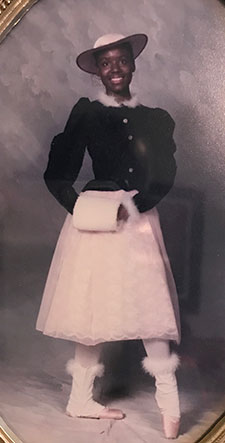 How do you feel ballet has shaped you as a person?
How do you feel ballet has shaped you as a person?
“For me, I’ve always been a person that can be really good at things without working too hard — but only certain things. So if something wasn’t easy for me, I would just do something else. But, ballet wasn’t easy for me at the beginning. My teacher, Miss Ludmilla, was just there, with me, on me, and she pushed me. Without that one-on-one interaction from her, I probably would have let it go earlier than I did. I remember specific days when she would come up to me in class and say, ‘Look at these muscles coming out. This is because you’re taking class so many times a week…’ or ‘Your body shape is good for doing really high jumps.’ She would do that with everyone. She would say, ‘you have the gift of having extension,’ or ‘look how you can turn.’ Everybody felt like they had these special gifts.”
Did you face any challenges in your pursuit of ballet?
“I don’t know if I felt actual racism in our dance school. There were a few other girls of color and boys of color in our dance company, and I felt that they got the roles that were commensurate with their level of talent. I didn’t feel that I couldn’t (achieve a role because of my color). I did know that I was one of the only ones, but that wasn’t really different from all of my other school activities.
But I have to talk about this other issue that I’ve had with ballet. When I was in college I came in as someone who had taken all of this classical ballet. Most of the classes were modern dance, so I had to kind of let that go, let it go out of my body. My best friend in college was a choreographer, and she was not a ballet dancer. She explained to me how ballet is Eurocentric, and that ballet pushed these European standards of beauty onto all dancers.These concepts expanded my mind, allowing me to see that there are so many types of dance besides ballet. During that time of my life, it was sort of uncool for me to love ballet because of the cultural references. It made me feel like I couldn’t love ballet as much because I was supposed to be searching for my own culture. I mean, I’m glad that it happened to me because it really opened my mind. You don’t have to have ballet training to be a good dancer, which I think is one of the main points she was trying to assert.
When I came to Pittsburgh and was in my residency, I took ballet for exercise, because I knew that was the best way for me to work out my body. It still is. Not until the last five years, when I started to really be involved in PBT and (a friend) got me back into ballet, did I realize that it’s OK for me to love ballet. And then with Misty (Copeland’s promotion to principal at American Ballet Theatre), it also helped me be like, ‘Hey I can love ballet and be a black woman.’ While in the past, I felt like I shouldn’t express my love for ballet because it was so European. But I don’t care anymore, I love ballet!
Now I think if we’re open to cultural diversity then…I think everyone can participate in it now and enjoy it in so many different ways. I’m glad that people are pushing to broaden and participate in their own way. I think the whole concept of Misty Copeland has allowed black girls, and women, to love ballet and proudly participate in it as a welcome part of the art form. There are so many different types of ballet choreographers now from all different cultures. I think we’re going to see a big widening and broadening of the field and what is ballet.”
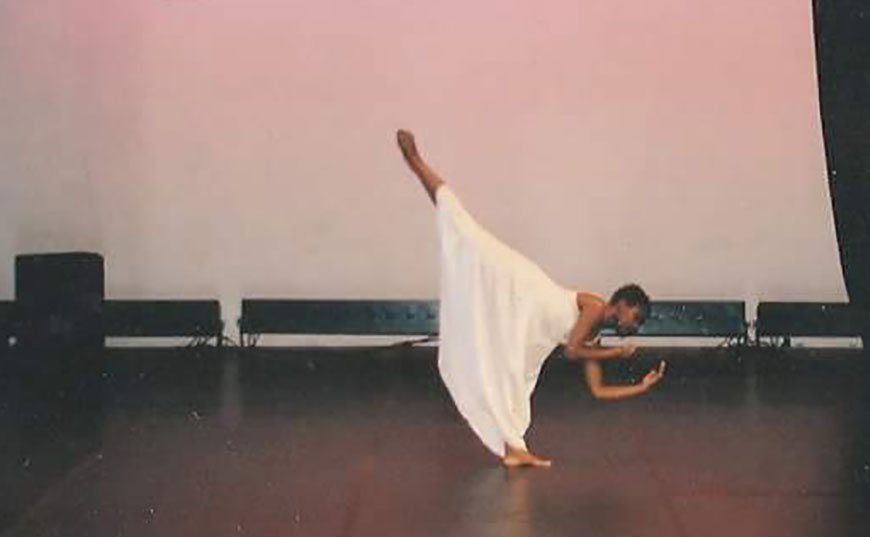
Did it help you discover an inner joy or sense of expression?
“Yeah, I think so. In high school you get to be involved in this whole other world. I played music, I played the flute and I was in band. I didn’t feel as much of an ability of self-expression as I do with dance and with ballet. Even after I stopped taking a lot of the high-intensity class schedules for ballet, I always was known as a dancer at school. I choreographed the school musical and other things. I felt like people knew me as a special talent. I won the talent show in sixth grade, so after that everyone knew that I was a ballet dancer.”
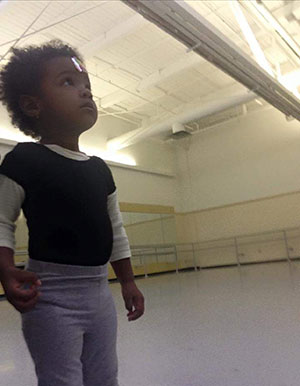
Now your daughter, Lalitha, is taking ballet classes. What do you see it bringing to your daughter’s life?
“I was so excited to take her (to her first Mommy and Me ballet class at Pittsburgh Ballet Theatre). I was like, ‘OK, you gotta get this under control because this is not about you anymore…I don’t want to push this on you.’ But she really loved it. I should share part of something I wrote to her on that day…
Dear Daughter,
On your first dance class, I may have been overjoyed about the fact that this happened today. I am not going to push you. But I do feel a special fulfillment in sharing something I love so much with you… I hope someday that you love something as much as I have loved and still love to dance — ballet and many other forms. God help me to open doors to many opportunities for you to choose your passion — whatever they may turn out to be…
Right now both of my little girls love ballet, and they’re around it a lot because of my involvement. If they really want to do it they certainly can. What I’m excited about is that they see so many girls of color in their dance classes and onstage…Lalitha just thinks it’s a regular thing. If they want to, the door is so wide open, but I certainly don’t want to push them. Right now it’s just about exposure.”
Why is this collaboration important to you personally and why do you think it’s important for our community?
“I just think it’s a doorway to get a whole bunch of people connected…It allows people to fall in love with ballet who may have thought ballet isn’t for me or it’s not for us. If they’re excited about Dance Theatre of Harlem and they come and see, I think people will get excited for the kids who may have opportunities to do ballet in a way that maybe they didn’t feel was a door that was open to them. I just feel like most people in Pittsburgh, when you talk about Dance Theatre of Harlem, get really excited. They’re excited about the history of DTH and how hard they’ve had to work to be there. Some of that same history is at PBT too in a different way. I think that it’s a real stepping stone to really widen the audience and widen the opportunities for kids in Pittsburgh to come and take ballet. It’s not going to be everyone’s career, for sure, but it can be a really important part of your upbringing.”
One thing that’s kind of funny is that my husband has never seen my dance. All the people who know me now, they know me as doctor, as a physician, as a mom. People that knew me in college and in high school and younger, they knew me as a dancer. They can’t believe I’m a doctor now. It’s so funny, because it’s so much of my identity in the past. I’m so glad now it’s becoming part of my identity in a new way.”
#FacesOfBalletPgh: Daniela Moya
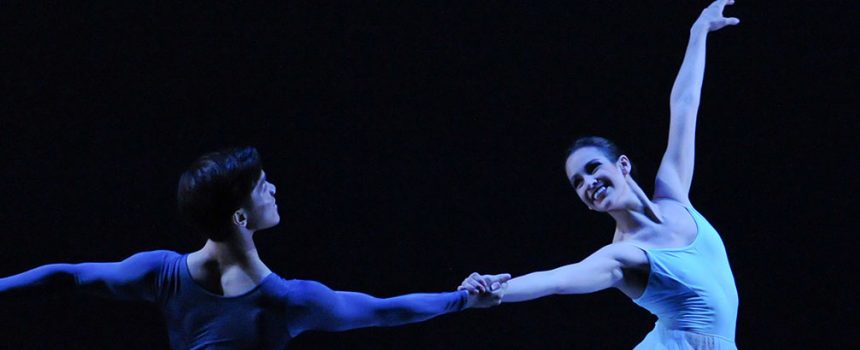
There’s Only Plan A: Why One Ballerina Followed Her Dream to the United States
For Daniela Moya, ballet has always been part of the plan. She started dancing at age 4 – an age when “ballerina” isn’t an uncommon career aspiration. But for Daniela, this was no passing phase. Ballet had her hooked – from the rigor of training to its release of emotion – and she became determined to make it her life’s work. Six years ago, the PBT Corps de Ballet dancer left her family, friends and hometown of Mexico City to chase her dream to the United States. She accepted a spot in Joffrey Ballet’s trainee program in Chicago and went on to train in the PBT School Graduate Program before signing with the company in 2016. The transition hasn’t been without its challenges. Thanks to the love of dance and the support of Facetime, family visits and her loyal pups, she can still confidently say, “there’s only Plan A…and there’s only going forward.”
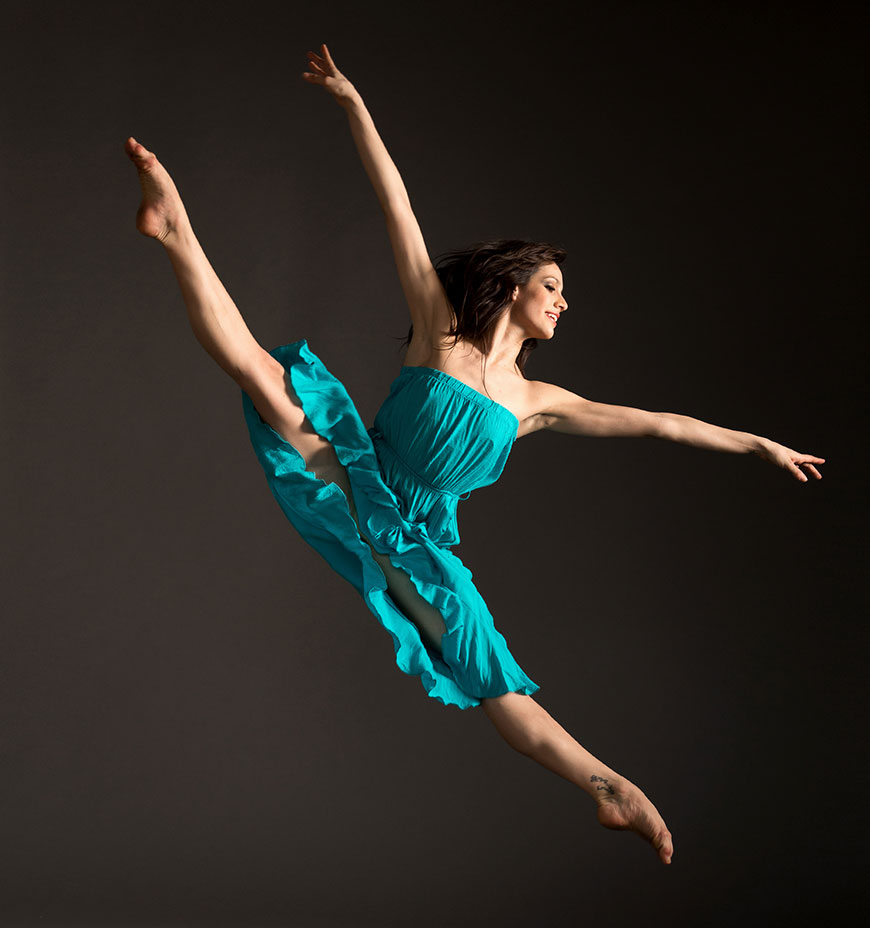
Describe your first encounter with ballet. What hooked you?
“My first encounter was when I was four. My mom took me because the doctor said ballet would help (with my posture). I walked like a duck. I just really liked ballet and the challenge of it. It’s really disciplined. Technique-wise, it’s not where your body wants to go naturally. You don’t force it, but you have to train your body to move that way for it to be correct. That’s the hard part. Also, what I love about it is the artistry you can bring to it so that it looks effortless and natural.”
When was your ballet “epiphany” – the moment you knew you wanted to pursue this art form not only as a hobby but as a career?
“Since I was little I always said I was going to be a ballerina. That was always my thing. My parents were like, ‘Yeah, yeah, sure, sure, you’ll grow out of it.’ And then one summer intensive (at the Royal Ballet) when I was a teenager, I went to London and it was one of the first times that I went out of the country and away from my family. We created this production at the end of the program, and my mom came to watch. Just waiting in the wings to go out gave me that adrenaline rush, and I thought, ‘I want this. This is it.’”
What was one challenge that you had to overcome in order to make your dream a reality?
“There were many – but three in particular. First of all was my posture. In order to do ballet, I really had to concentrate. And still today, I try to focus on my posture, because it’s my weak point. Second was trying to like myself in order to be healthy. You look at yourself in the mirror in a leotard and then you get obsessed with how skinny you are. It was overcoming that mental (fixation) on how I looked. You just need to dance and not focus on your body. Third was just moving away from my family. When the moment came it was, ‘Yep, I’m going (snaps fingers).’ But once I was here I thought, wow I did leave everything behind. (But now) there’s only going forward…I guess my mind was set on Plan A. My mom was like, ‘but what if it doesn’t work out? Just come back. Plan B.’ And I said, ‘No, there’s only Plan A.’ I already moved away. I left everything – my friends, my family. I’m by myself. There’s only one way. Whatever means moving forward. That was it.”
What makes all of the hard work and sacrifice worth it to you?
“I guess just getting better. You could be at the top of your class, and then you move to another class and you’re at the bottom again. When I moved to Chicago, it was completely different, but I really wanted it. (Sometimes you think) maybe I’m not good enough. I think I am, but maybe I’m not. But then you have meetings and people keep pushing for you and telling you it’s the right thing to do, that you should be dancing. Sometimes the encouragement was the only thing that kept me going. I thought, OK I’m doing the right thing, so I just kept going.”
Culture-wise, the food adjustment was the most difficult. I had to figure out what to eat to be healthy and that was easy (to prepare) – trying to figure out what to make and modify. I always missed my Mexican food. Also the hours of eating are so different than back home. Food is huge (to my culture at home). When my mom is here, we just go out to eat (laughs). My first year was really lonely and then I got my dog. I mean I had friends, I met Diana Yohe (a fellow Joffrey trainee and current PBT dancer), and then I got my dog and I was like OK, now I’m good.”
What advice would you give an aspiring dance or to your younger self?
“I would have said to start earlier. I would just say to not give up. I had those moments of doubt. I might have wasted a little more time trying to figure it out instead of to keep pushing. Patience and perseverance will get you somewhere.”
What rewards all of your hard work? What makes it all worth it?
“What makes it worth it is that I’m still dancing. This is funny, but I made a note to myself with a friend back at home and what we’d be doing when we were 25. I looked back at it when I turned 25…It was to be in a professional company, to be dancing, to have traveled. I think I’ve accomplished a lot of that. It’s been my dream, so it’s just still rewarding that I’m still dancing.”
What excites you about ballet’s future and its possibilities?
“I think it’s always changing. There’s new choreographies and new music. There are new ideas that may not be classical, but I think that’s part of the challenge – to try to be versatile and learn to move however your body can move. It’s fun, because I feel like people are getting more educated about ballet, so more people come to see it and realize that it’s fun to watch. You don’t have to dance it (to enjoy it)…It’s an art form but it’s also athletic and it’s also entertaining. You just have to try it and see if you like it.”
Why do you think dance is universal?
“I feel like it’s a different kind of language. I’ve seen it with me, coming to a different country, maybe meeting a dancer from Japan, for example. Maybe we don’t share the same language, but we dance. We can get together and have the same dance. You express yourself, your feelings. You can show the music. It’s pretty diverse. You can speak through it.”
What advice would you give a young dance student today (or yourself at a younger age)?
“Just do it. Life doesn’t work without risks. It’s boring. I’m going to sound super cheesy, but there’s a saying, ‘Find the job that you’re passionate about and then you don’t have to work the rest of your life.’ I just want to dance.”
Why do you find the PBT & DTH collaboration so exciting?
“It’s very inspiring to see another company work and perform so close. Just like in the real world, having connections and integrating ourselves with other people (in this case dancers) is so beneficial. We learn a new perspective, and like I said before, we have the same language. It is just how we express that language and wish to share that artistry with the public that is different for both companies and individual dancers.”
Beat the Winter Blues: 5 Reasons People Are Going Mad for ‘Alice’
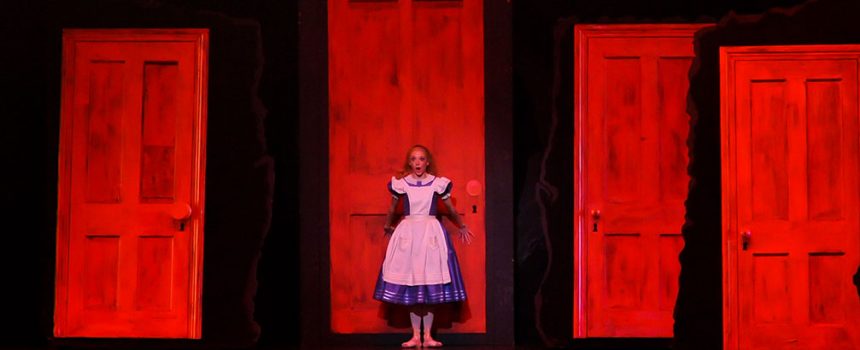
Sick of short days, gray skies and cabin fever? Ditch reality, embrace the madness and find out why people are raving about their wild trip to PBT’s Alice in Wonderland. This imaginative production is onstage through Feb. 19, at the Benedum Center. Get your tickets before it’s too late!
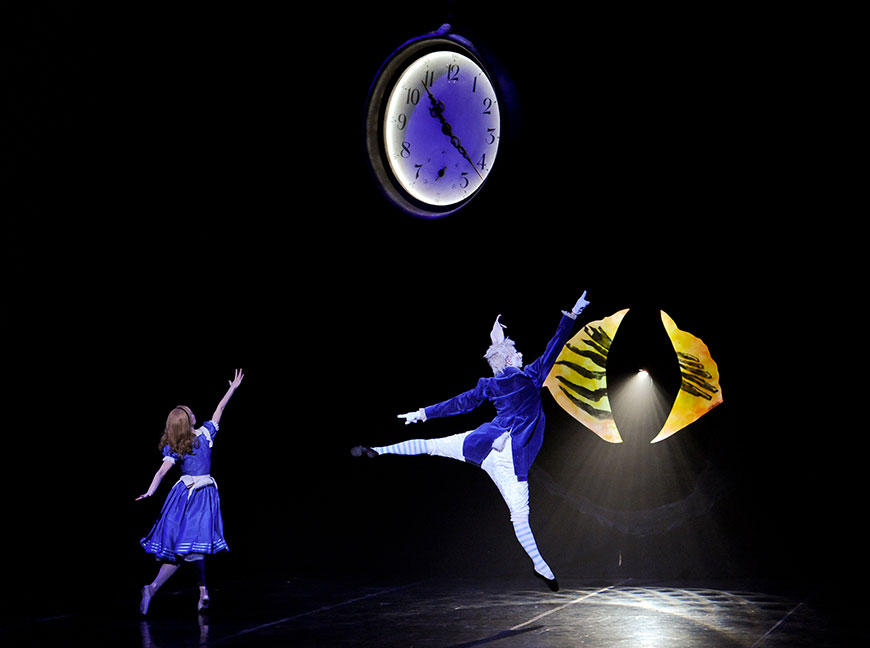
1. The stagecraft is simply astonishing. Floating clocks, confusing corridors of doors, teapots that pour on command, Queens who appear out of thin air – we’re all mad here.
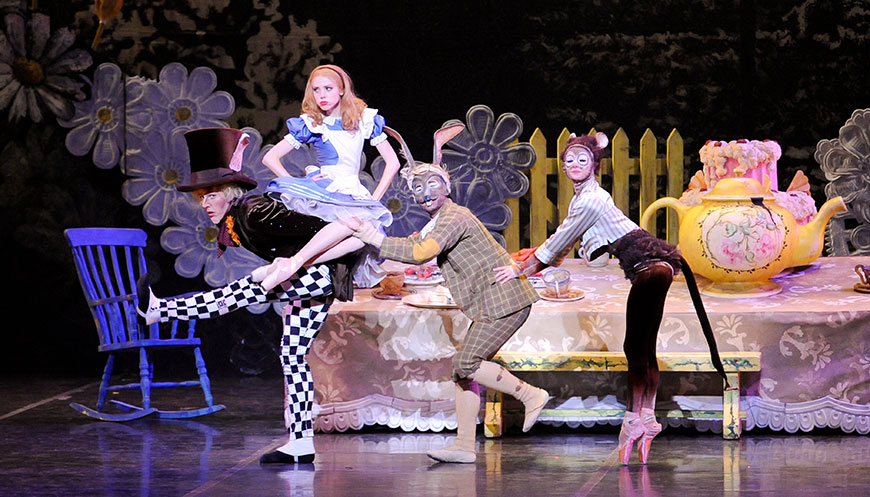
2. Kids can’t get enough. From a dancing dormouse to mind-blowing magic tricks, there’s never a dull moment. According to one Tweeter, her six-year-old son was “ENTHRALLED.” Her advice? “Go now!”
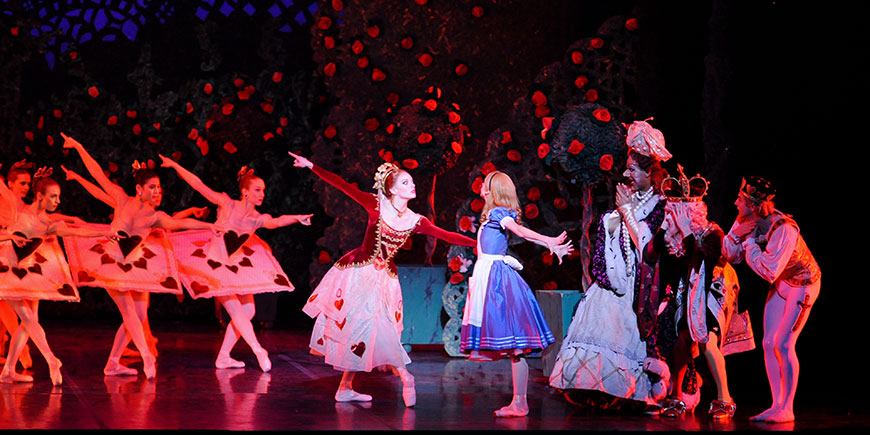
3. The Queen of Hearts’ performance is “DELICIOUSLY WICKED (Pittsburgh City Paper).” You’ll literally see red when the Queen loses her head over a game of croquet.
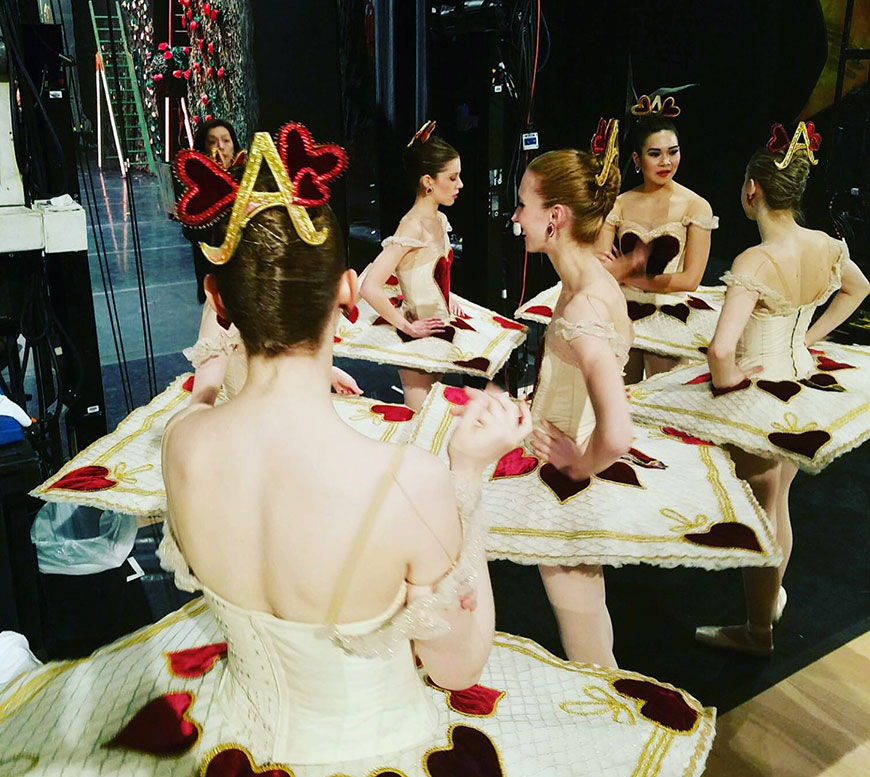 4. And, according to Facebook, everybody loves those tutus made of playing cards.
4. And, according to Facebook, everybody loves those tutus made of playing cards.
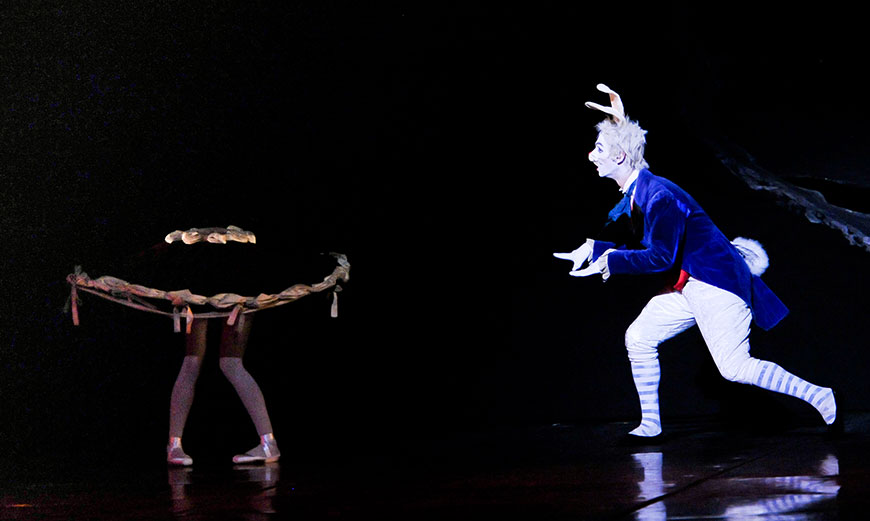 5. Really, it just “hit all the high points — from a surreal transition to Wonderland, replete with torso-less tutus and floating teapots, to the Rose Garden, dominated in no uncertain terms by a glamorous villainess, Queen of Hearts Julia Erickson (Pittsburgh Post-Gazette).”
5. Really, it just “hit all the high points — from a surreal transition to Wonderland, replete with torso-less tutus and floating teapots, to the Rose Garden, dominated in no uncertain terms by a glamorous villainess, Queen of Hearts Julia Erickson (Pittsburgh Post-Gazette).”
Getting curiouser and curiouser, but still need convinced? Find more interesting tidbits about the ballet here.
